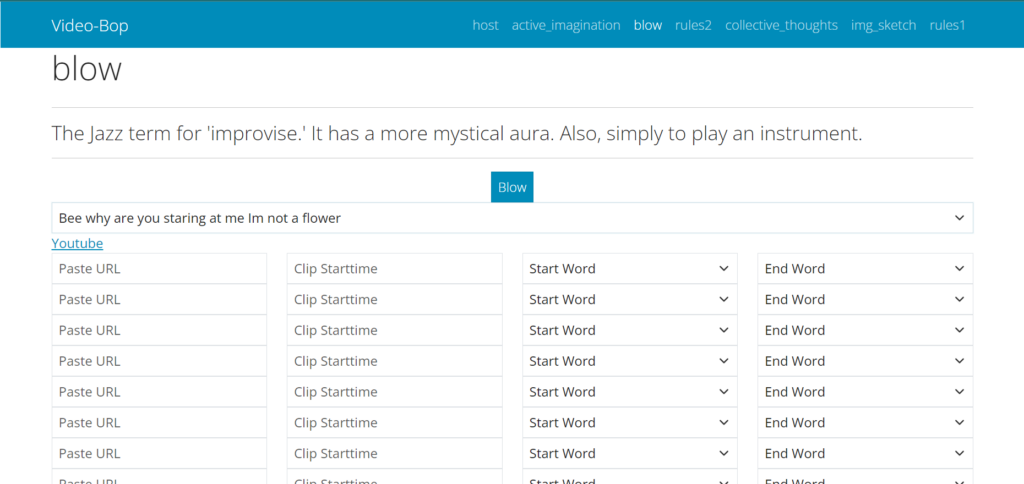Cycle 2: Video-Bop
Posted: May 1, 2024 Filed under: Uncategorized | Tags: Cycle 2 Leave a comment »Feedback from cycle I directed me towards increased audience interactivity with the video-bop experience.
Continuing in the spirit of Kerouac, I was inspired by one of his recordings called American Haikus in which he riffs back and forth with tenor saxophone player Zoot Sims. Kerouac, not being a traditional musical instrumentalist (per say), recites his version of American Haiku’s in call and response with Zoot’s improvisations:
“The American Haiku is not exactly the Japanese Haiku. The Japanese Haiku is strictly disciplined to seventeen syllables but since the language structure is different I don’t think American Haikus (short three-line poems intended to be completely packed with Void of Whole) should worry about syllables because American speech is something again… bursting to pop. Above all, a Haiku must be very simple and free of all poetic trickery and make a little picture and yet be as airy and graceful as a Vivaldi Pastorella.” (Kerouac, Book of Haikus)
Kerouac’s artistic choice to speak simple, yet visually oriented ‘haikus’, allows him inhabit and influence the abstract sonic space of group improvised jazz. These haikus are at par with the music motifs typical of trading which is when the members of jazz ensemble will take turns improvising over small musical groupings within the form of the tune they are currently playing. What I find most cool is how you can feel Zoot representing Kerouac’s visual ideas in sound and in real-time. In this way, a mental visual landscape is more directly shaped by merging musical expression and the higher cognitive layer of spoken language. It is not new for abstract music to be given visual qualities. Jazz pianist Bill Evans described the prolific ‘Kind of Blue’ record as akin to “Japanese visual art in which the artist is forced to be spontaneous…paint[ing] on a thin stretched parchment.. in such a direct way that deliberation cannot interfere”(Evans, Kind of Blue Liner notes 1959)
As a new media artist, I tried to create a media system which would engage the audience in this creative process of translating abstract ideas of one form into another. I believe this practice can help externalize the mental processes of rapid free association. To do so, I had to build a web-application accessible to the audience connected to a cloud database which could be queried from my PC running the Isadora media software. This web-app could handle the requests of multiple users from their phones or other smart-devices with internet access. I used a framework familiar to me using Dash to code the dynamic website, Heroku to host the public server, and AstraDB to store and recall audience generated data.
See src code for design details
The experience stared with the audience scanning a QR code to access the website, effectively tuning their phones into an interactive control surface. Next, they were instructed to read Kerouac’s Essentials of Spontaneous Prose which humorously served as the ‘rules’ for the experience. This was more of a mood setting device to frame the audience to think about creativity from this spontaneous image oriented angle.

Next, I played a series of Kerouac’s Haikus and instructed the audience to visit a page on the site where they could jot their mental events for each haiku as they listened to the spoken words and musical interpretation by Zoot. After this, there was a submit button which sent all their words to the database and was then dynamically rendered onto the next page called ‘collective thoughts’. This allowed everyone in the audience to anonymously see each other’s free associations.
Example from our demo

After, reading through the collective image-sketches from the group, we decided on a crowd favorite Haiku to be visualized. The visualization process was equipped to handle multiple Youtube video links with timecode information to align with the time occurrence of spoken words in a prerecorded video. This process followed form from Cycle I in how I quickly explored Youtube to gather imagery which I thought expressive of the message within the ‘History of Bop’ Poem. This practices forces a negotiation in expression between original image thoughts and the available videos on the medium of Youtube equipped with its database of uploaded content and recommender systems. An added benefit to having the interaction on their personal phones is that it connects to their existing Youtube app and any behavioral history made prior to entering into the experience. The page to add media looked like this:

This was the final step and it allowed tables to be generated within the cloud database which were in a form for which they could be post-processed into a json file which worked with the visualizing patch I made in Isadora for Cycle 1. I had written a python script to query the database and download all of the media artifacts and place them into the proper format.
Unfortunately, I didn’t have much time to test the media system prior to presentation day and the database was overwritten due to a design issue. Someone had submitted a blank form which overwrote all of the youtube data entered by the other audience members. For this reason, I was not able to display the final product of their efforts. Yet, it was a good point of failure for improvement in cycle 3. The audience was disappointed that they didn’t see the end product, but I took this as a sign that the experience created an anticipation which had powerful buildup.